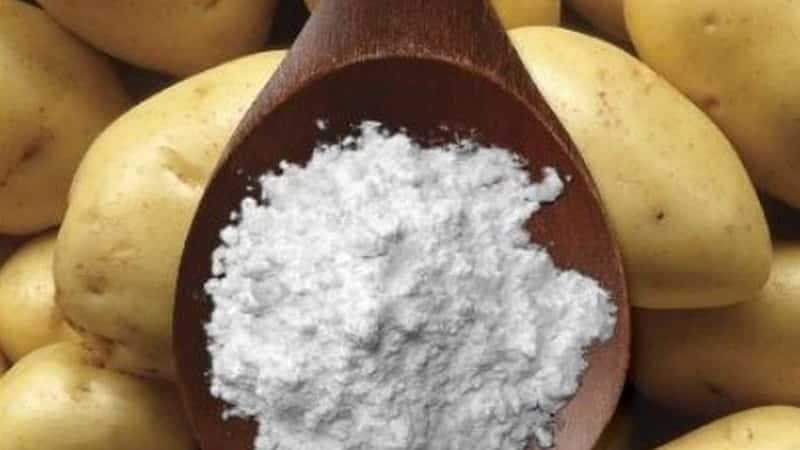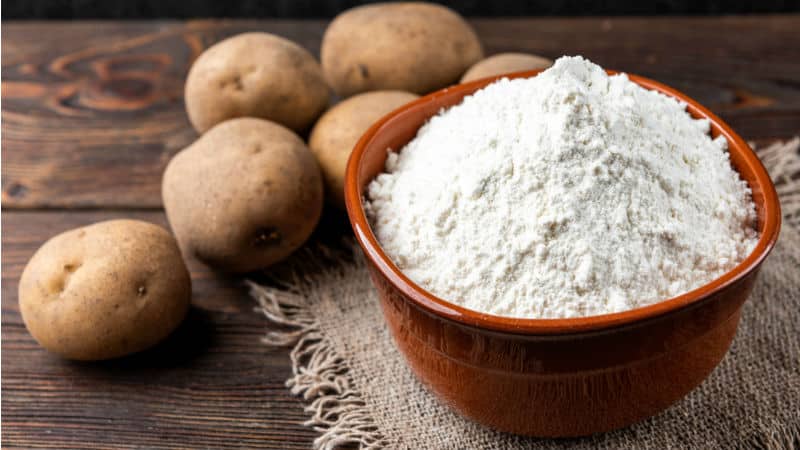Starch in potatoes: varieties with high and low content
Different varieties of potatoes have different nutrient ratios. Thus, the amount of starch in potatoes largely determines its taste and ability to boil. We offer a more detailed description of potato varieties with low, medium and high percentages of starch.
Properties of starch in potatoes
Starch is a carbohydrate found in large quantities in raw potatoes. This substance provides nutrition to the plant during development and remains in the tubers after they are dug up.
Starch gives the tubers nutritional value, so the body is saturated with energy after eating potatoes, even in its pure form without meat.
There are both pros and cons to this. The downside is that starch in the gastrointestinal tract breaks down into glucose, which increases blood sugar levels. The advantages are the enveloping properties of the substance (which is good for patients with gastritis and ulcers), the boiliness and taste of potatoes. Potatoes are well absorbed by the body and are quickly digested, ensuring smooth functioning of the gastrointestinal tract.

Potato high starch content it is more nutritious, cooks faster, forms a lot of foam during cooking and emits a pleasant aroma. The low proportion of polysaccharides makes the tubers less nutritious and hard, but closer to dietary food.
The percentage of starch in the composition largely depends not only on the variety, but also on the yield, weather conditions, and the size of the tubers.
Reference. The smaller the potato, the more starch it contains, and vice versa.
Potato varieties with high starch content
Starchy potatoes have a low percentage of moisture inside the tubers, so the tubers quickly crumble when cooked, absorbing water from the container. They are typically light yellow to dark brown potatoes with a rough, thick skin that is often rough to the touch.

A high proportion of potato starch, about 16-18%, is typical for the following varieties:
- Zhuravinka grown in mid-latitudes and distinguished by its rough, reddish skin. Potatoes are yellow inside, have excellent taste, but ripen late.
- Elizabeth ripens early, common in northern latitudes. These are large round potatoes with smooth skin, on which the eyes are practically invisible, white inside.
- Bashkir Potatoes also ripen early and have red skin and white flesh. Unlike other varieties with a large amount of starch, Bashkir is denser.
- Aurora – one of the most delicious varieties of potatoes. Tubers with cream-colored pulp and smooth pinkish skin. They prepare quickly and practically do not change color after heat treatment.
It is preferable to boil starchy potato varieties for mashed potatoes or thick soups, or bake. With such potatoes, the body is saturated much faster due to the increased calorie content of the tubers.
Separately, it is worth highlighting potatoes with a starch content of 25% or more. These are technical varieties that are grown for feed for farm animals, as well as for the production of potato starch and alcohols. They are rarely consumed as food precisely because of the excessive proportion of this carbohydrate.
Medium starch potato varieties
They are good because, despite the large amount of starch, they hold their shape well during heat treatment and are therefore suitable for almost any purpose. These potatoes can be either boiled or fried.
It will not disintegrate, but can be easily crushed if necessary. These are usually golden, oval-shaped tubers with medium-thick skin. The proportion of starch in the composition is from 13 to 16%.

Medium starch potato varieties:
- Early ripening Red Lady potatoes It is distinguished by its large weight and size of tubers, light red skin and yellowish flesh. Grown mainly in the north, it is particularly unpretentious in care.
- The Sineglazka variety is very popular. These are oblong tubers with pronounced eyes. It is easy to distinguish from others due to its blue peel. At the same time, the flesh inside is white. The mild sweetish taste of the tubers sharply distinguishes Sineglazka from other varieties. Accordingly, its price is higher.
- Lapis lazuli popular because it does not require special conditions for cultivation and is therefore distributed almost everywhere. The skin of the tubers is bright yellow and the flesh is white.
Potatoes with a medium starch content can be consumed in moderation by people suffering from diabetes if the tubers are pre-soaked in water.
Low starch varieties

These are potatoes containing up to 13% of the substance. These varieties are suitable for boiling in their skins, preparing salads in which vegetables are cut into cubes, and for soups. The tubers have particularly thin skin.
Potato varieties with low starch content:
- Nevsky – small pink tubers with white flesh. It is grown everywhere, has good taste, and is quick to prepare. It is especially suitable for frying.
- Zhukovsky – early ripening, with small reddish tubers. Suitable for boiling in salads.
- Leader It is characterized by rapid ripening - as a rule, the harvest is harvested within 45 days after planting. The tubers are round, white, and have a smooth skin.
Potatoes with a low percentage of starch are suitable for people with diabetes and those prone to obesity. It does not even need to be soaked in water, but if this is done, the percentage of polysaccharide will be reduced to a minimum. However, as a result, the tubers will become tough and their heat treatment will take longer.
Reference. Such potatoes are suitable for preparing fresh juice, which is often used for medicinal purposes.
What are starchy potatoes used for?

As mentioned above, starchy potato varieties use for dishes where complete boiling of the tubers is necessary. They are also used for the production of starch.
Important! The less fertilizer is used when growing potatoes, the more polysaccharide there is in the tubers.
Starchy vegetables are indispensable in cases where you need to get enough of less potatoes.
High-starch varieties are divided into several varieties according to their intended purpose:
- Universal potatoes are equally suitable for both food consumption and the production of starch and other substances.
- Ware potatoes are grown in the greatest quantities because applies for sale. The rate of starch in such tubers corresponds to GOST.
- Industrial potatoes are used for the production of alcohols and starch, and animal feeding.
- Fodder potatoes are distinguished by an increased percentage of not only starch, but also protein in their composition, which distinguishes them favorably from technical potatoes.
Conclusion
Starch is the main element in potatoes. Thanks to it, the vegetable acquires energy value. In order not to spoil the dish, it is important to know which varieties of potatoes are suitable for which dishes. If you don't know how to determine the amount of starch, just cut a potato and rub the halves together. Gluing will indicate high starch content, and the presence of liquid will indicate low starch content.
Proper selection of the appropriate potato variety, as well as the use of the optimal amount per serving, will make the diet balanced and the culinary process easy and quick.
Very useful information, available for selection, brief and on topic. Thank you.